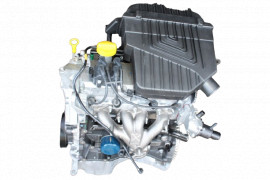Opel Corsa Engine: Performance and Reliability for Your Car
Opel Corsa Engine: Performance and Reliability for Your Car
Blog Article
Checking Out the Inner Operation of a Compact Lorry's Engine System
As drivers, we typically take for approved the intricate procedures that take place within the confines of our car's engine system. In this expedition of a compact car's engine system, we will certainly unravel the inner functions of this mechanical harmony, dropping light on the secrets that drive us onward on our daily trips.
Burning Process Introduction
The burning process in a compact vehicle's engine system is an important system that effectively converts fuel right into energy to power the lorry. This process takes place within the combustion chamber of the engine, where gas and air mix, spark, and create regulated explosions. The combustion procedure is composed of 4 major stages: intake, compression, exhaust, and power.
During the intake phase, the piston moves downward, attracting in a mix of air and fuel right into the burning chamber. This down movement generates the power required to drive the vehicle. This cyclic combustion procedure is fundamental to the operation of a small automobile's engine system, making sure effective power conversion for propulsion.
Piston and Cylinder Interaction

The piston's specific fit within the cyndrical tube is essential for keeping ideal compression and protecting against energy loss during combustion. Limited clearances in between the piston and cyndrical tube wall surfaces make sure reliable securing, enabling the piston to relocate smoothly without permitting gases to leakage past. Appropriate lubrication is also important to minimize rubbing and wear in between these components, improving durability and performance.
Additionally, the layout and products used in manufacturing the piston and cyndrical tube impact engine performance and resilience. Modern engines commonly utilize light-weight yet resilient products like aluminum alloys for pistons and cyndrical tube linings to decrease inertia and enhance thermal efficiency. Overall, the harmonious interaction between the piston and cylinder is essential to the engine's capability and total efficiency.
Gas Shot System Capability
Gas shot systems in portable car engines play an essential role in specifically supplying fuel to the combustion chamber for efficient and regulated ignition. The fuel injection system operates by injecting fuel right into the burning chamber at the optimum minute throughout the engine's operation (opel corsa engine). This exact timing guarantees that the fuel blends uniformly with the air for correct burning, bring about improved gas effectiveness and minimized discharges
There are mostly 2 types of gas shot systems used in portable lorry engines: port gas shot (PFI) and direct fuel injection (DFI) PFI systems inject gas right into the intake port before the consumption valve, while DFI systems inject gas straight right into the combustion chamber. Both systems have their advantages, with DFI using better gas atomization and PFI providing a much more economical remedy.
Recognizing Engine Cooling Mechanisms
Effective operation of a portable lorry's engine counts heavily on the efficiency of its cooling mechanisms. Engine cooling is necessary to avoid overheating, which can cause severe damage and lowered performance. The cooling system in a portable lorry generally contains a number of elements working with each other to manage the engine temperature. One critical part is the radiator, which uses coolant to take in heat from the engine. As the warm coolant streams with the radiator, it releases warmth into the air, cooling off prior to going back to the engine. The water pump circulates the coolant via the engine dig this and radiator, ensuring a consistent flow to manage temperature level. In addition, the thermostat helps manage the coolant circulation to preserve optimum engine temperature. Some automobiles likewise have cooling followers that activate when additional cooling is required, such as during rush hour or heat. Understanding these engine cooling mechanisms is vital for maintaining the performance and longevity of a compact automobile's engine system.

Exhaust System Parts Explained
The optimum functioning of a portable car's engine air conditioning systems depends on a complementary system known as the exhaust system, which comprises numerous crucial elements for guaranteeing effective emissions and engine performance. The exhaust manifold accumulates exhaust gases from the engine's cylinders and courses them to the catalytic converter.
One crucial element of the exhaust system is the oxygen sensor, which monitors the oxygen levels in the exhaust gases to assist control fuel intake and guarantee optimum engine performance. opel corsa engine. Additionally, Go Here the resonator may exist in some exhaust systems to reduce sound degrees. In general, the exhaust system plays a crucial duty in preserving engine effectiveness, decreasing damaging discharges, and making certain a quieter driving experience for portable car owners

Final Thought
Finally, the portable lorry's engine system is an intricate mix of components that interact to help with the burning process, convert fuel right into power, and get rid of waste gases. Understanding the inner operations of the engine system, including the piston and cylinder communication, fuel shot system, engine air conditioning devices, and exhaust system parts, is essential for keeping ideal performance and effectiveness of the lorry.
The burning process in a portable automobile's engine system is an important device that effectively converts fuel into energy to power the lorry.Fuel injection systems in compact vehicle engines play an important role in specifically supplying fuel to the burning chamber for regulated and reliable ignition.There are mostly two types of fuel injection systems made use of in small automobile engines: port fuel shot (PFI) and straight gas injection (DFI) Recognizing these engine cooling mechanisms try here is crucial for keeping the performance and long life of a portable vehicle's engine system.
The optimal functioning of a small car's engine cooling devices depends on a complementary system known as the exhaust system, which makes up different essential components for making sure effective exhausts and engine performance.
Report this page